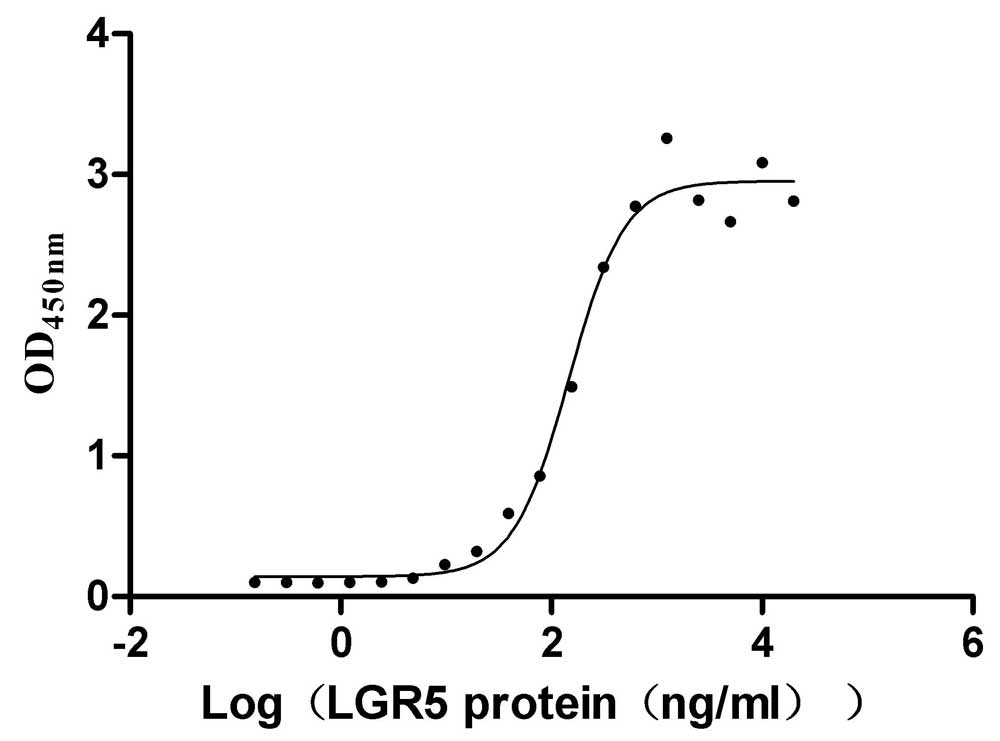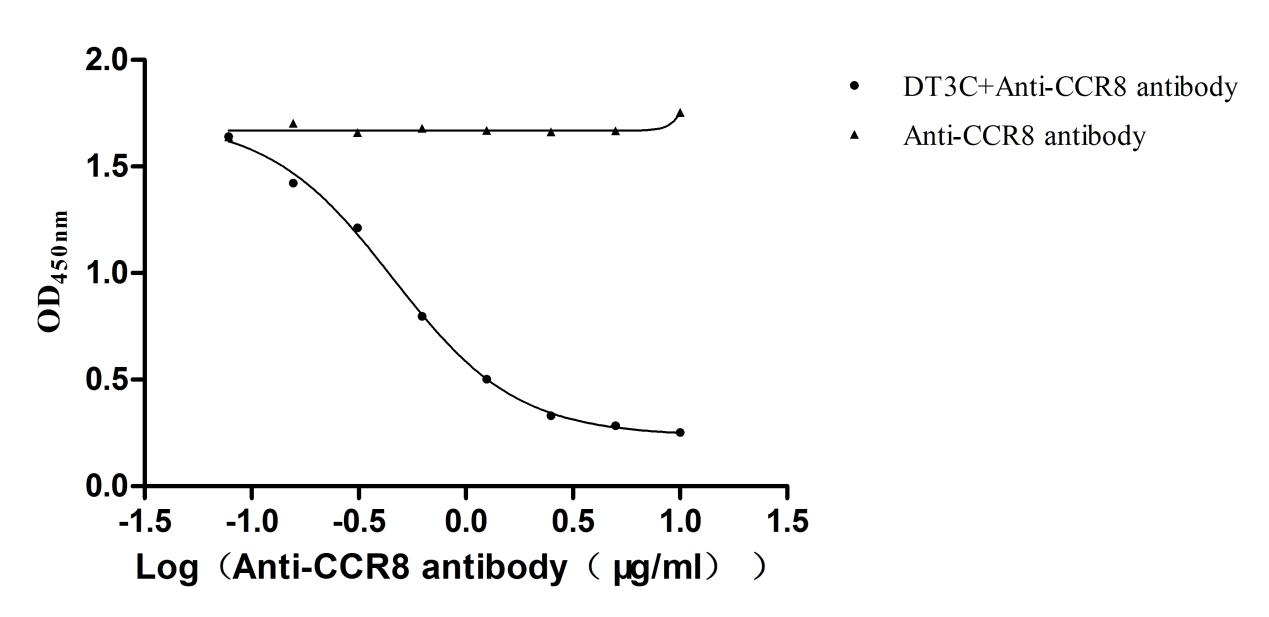Recombinant Mouse Heat shock cognate 71 kDa protein (Hspa8)
-
货号:CSB-YP010829MO
-
规格:
-
来源:Yeast
-
其他:
-
货号:CSB-EP010829MO-B
-
规格:
-
来源:E.coli
-
共轭:Avi-tag Biotinylated
E. coli biotin ligase (BirA) is highly specific in covalently attaching biotin to the 15 amino acid AviTag peptide. This recombinant protein was biotinylated in vivo by AviTag-BirA technology, which method is BriA catalyzes amide linkage between the biotin and the specific lysine of the AviTag.
-
其他:
-
货号:CSB-BP010829MO
-
规格:
-
来源:Baculovirus
-
其他:
-
货号:CSB-MP010829MO
-
规格:
-
来源:Mammalian cell
-
其他:
产品详情
-
纯度:>85% (SDS-PAGE)
-
基因名:
-
Uniprot No.:
-
别名:Hspa8; Hsc70; Hsc73; Heat shock cognate 71 kDa protein; Heat shock 70 kDa protein 8
-
种属:Mus musculus (Mouse)
-
蛋白长度:Full Length of Mature Protein
-
表达区域:2-646
-
氨基酸序列SKGPAVGID LGTTYSCVGV FQHGKVEIIA NDQGNRTTPS YVAFTDTERL IGDAAKNQVA MNPTNTVFDA KRLIGRRFDD AVVQSDMKHW PFMVVNDAGR PKVQVEYKGE TKSFYPEEVS SMVLTKMKEI AEAYLGKTVT NAVVTVPAYF NDSQRQATKD AGTIAGLNVL RIINEPTAAA IAYGLDKKVG AERNVLIFDL GGGTFDVSIL TIEDGIFEVK STAGDTHLGG EDFDNRMVNH FIAEFKRKHK KDISENKRAV RRLRTACERA KRTLSSSTQA SIEIDSLYEG IDFYTSITRA RFEELNADLF RGTLDPVEKA LRDAKLDKSQ IHDIVLVGGS TRIPKIQKLL QDFFNGKELN KSINPDEAVA YGAAVQAAIL SGDKSENVQD LLLLDVTPLS LGIETAGGVM TVLIKRNTTI PTKQTQTFTT YSDNQPGVLI QVYEGERAMT KDNNLLGKFE LTGIPPAPRG VPQIEVTFDI DANGILNVSA VDKSTGKENK ITITNDKGRL SKEDIERMVQ EAEKYKAEDE KQRDKVSSKN SLESYAFNMK ATVEDEKLQG KINDEDKQKI LDKCNEIISW LDKNQTAEKE EFEHQQKELE KVCNPIITKL YQSAGGMPGG MPGGFPGGGA PPSGGASSGP TIEEVD
-
蛋白标签:Tag type will be determined during the manufacturing process.
The tag type will be determined during production process. If you have specified tag type, please tell us and we will develop the specified tag preferentially. -
产品提供形式:Lyophilized powder
Note: We will preferentially ship the format that we have in stock, however, if you have any special requirement for the format, please remark your requirement when placing the order, we will prepare according to your demand. -
复溶:We recommend that this vial be briefly centrifuged prior to opening to bring the contents to the bottom. Please reconstitute protein in deionized sterile water to a concentration of 0.1-1.0 mg/mL.We recommend to add 5-50% of glycerol (final concentration) and aliquot for long-term storage at -20℃/-80℃. Our default final concentration of glycerol is 50%. Customers could use it as reference.
-
储存条件:Store at -20°C/-80°C upon receipt, aliquoting is necessary for mutiple use. Avoid repeated freeze-thaw cycles.
-
保质期:The shelf life is related to many factors, storage state, buffer ingredients, storage temperature and the stability of the protein itself.
Generally, the shelf life of liquid form is 6 months at -20°C/-80°C. The shelf life of lyophilized form is 12 months at -20°C/-80°C. -
货期:Delivery time may differ from different purchasing way or location, please kindly consult your local distributors for specific delivery time.Note: All of our proteins are default shipped with normal blue ice packs, if you request to ship with dry ice, please communicate with us in advance and extra fees will be charged.
-
注意事项:Repeated freezing and thawing is not recommended. Store working aliquots at 4°C for up to one week.
-
Datasheet :Please contact us to get it.
相关产品
靶点详情
-
功能:Molecular chaperone implicated in a wide variety of cellular processes, including protection of the proteome from stress, folding and transport of newly synthesized polypeptides, activation of proteolysis of misfolded proteins and the formation and dissociation of protein complexes. Plays a pivotal role in the protein quality control system, ensuring the correct folding of proteins, the re-folding of misfolded proteins and controlling the targeting of proteins for subsequent degradation. This is achieved through cycles of ATP binding, ATP hydrol...显示更多
-
基因功能参考文献:
- Post-transcriptional inhibition of HSPA8 expression leads to synaptic vesicle cycling defects in multiple models of amyotrophic lateral sclerosis. PMID: 28978466
- Synapsin is part of a multiprotein complex enriched in chaperones/cochaperones including Hsc70. Hsc70 chaperone activity is required for the cytosolic slow axonal transport of synapsin. PMID: 28559423
- Hsc70 interacts with FILIP to mediate its effects on non-muscle myosin IIb and to regulate spine morphology PMID: 28234934
- HSPA1A and HSPA8 have roles in parturition through stimulating immune inflammatory and estrogen response PMID: 28025138
- intracellular Salmonella recruit the host proteins LAMP-2A and Hsc73, key components of the host protein turnover pathway known as chaperone-mediated autophagy involved in transport of cytosolic proteins to the lysosome for degradation. PMID: 27932462
- these data demonstrate a novel interaction between Hsc70 and TH that regulates the activity and localization of the enzyme to synaptic vesicles, suggesting an important role for Hsc70 in dopamine homeostasis. PMID: 27365397
- C terminus of the hsc-70 LID domain as the structural interface interacting with endosomal Phosphatidylserine PMID: 27405763
- Hspa8 plays a vital role in genetic differences in responses to stress and ethanol and their interactions PMID: 26780340
- PTEN-like domains of GAK and auxilin are not essential for Hsc70-dependent chaperoning and uncoating of clathrin, but depending on the tissue, these domains appear to increase the efficiency of these co-chaperones. PMID: 26345367
- mass spectrometry-based proteomic analysis identified heat shock cognate 70 (HSC70) as a novel binding protein of FSP27 PMID: 25315694
- These findings indicate that wild type ILK and the non-oncogenic ILK(R211A) mutation comprise a cardioprotective module with Hsp/c70. PMID: 24260102
- these data provide evidence for Hsc70 as a novel neuronal interactor of NF-kappaB p65. PMID: 23762333
- In heat stress conditions, Hsp73 is mobilized to prevent apoptosis in the testes and epididymis, and assists Hsp72 in the repair of stress-altered protein conformations. PMID: 23352621
- Hsc70, Hdj1 and Hdj2 interact with soluble and fibrillar alpha-synuclein PMID: 21832061
- In this study, we report an identification of Hsc70 (Heat shock cognate protein 70) as a critical mediator of RGS9-2 expression that is specifically recruited to the intrinsically disordered C-terminal domain of RGS9-2 following dissociation from R7BP. PMID: 20095651
- data demonstrate for the first time that HSP70 overexpression with adenovirus injection prevented the lipopolysaccharide-induced increase in tumor necrosis factor-alpha and IL-6 levels in rats. PMID: 19551494
- Heat shock protein 70 (Hsc70) plays a significant role in vascular endothelial cells via the phosphatidylinositol 3-kinase/Akt pathway. PMID: 20018937
- surface located Hsc70 on trophoblast giant cells mediates the uptake of pathogenic bacteria and proteins containing the TPR domain inhibit the function of Hsc70 by binding to its EEVD motif PMID: 20003465
- Data show that ezrin associates with Hsc70 that locates on the membrane of TG cells and participates in the bacterial uptake by TG cells. PMID: 19737422
- Differential acquisition of antigenic peptides by Hsp70 and Hsc70 under oxidative condition. PMID: 12114509
- HSC70 has a specific tetratricopeptide repeat motif that enables it to bind to mSTI1 PMID: 12482845
- Hsc70 attenuates Dbl activity by maintaining an inactive conformation in which the amino terminus is "folded over" the catalytic DH-PH domain PMID: 15802271
- Results suggest an important role for KLF4 as a novel regulator of the constitutive expression of HSP73, but not HSP72. PMID: 18379898
- Data show that although Hsp70 and Hsc70 are both basally synthesized they have different cellular distributions, suggesting different Hsp70 activity with respect to Hsc70. PMID: 18841484
- Brucella abortus infection of trophoblast giant cells in placenta is mediated by Hsc70. PMID: 19055850
- These results imply the 70-kDa heat shock cognate protein-Toll-like receptor 4 interaction is a novel mechanism underlying the myocardial chemokine response to global ischemia-reperfusion PMID: 19448144
收起更多
-
亚细胞定位:Cytoplasm. Melanosome. Nucleus, nucleolus. Cell membrane.
-
蛋白家族:Heat shock protein 70 family
-
组织特异性:Ubiquitous.
-
数据库链接:
KEGG: mmu:15481
STRING: 10090.ENSMUSP00000015800
UniGene: Mm.290774

















